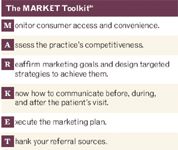Article
Your practice's marketing toolkit
How can my small group practice compete with the larger practices and the health system-owned practices, you may be asking?

Key Points

How do I put together a marketing plan that gets long-term positive results?
What do patients want that our practice isn't providing, and can I afford to offer those services?
To be successful, a medical practice must cultivate and satisfy its clientele by delivering consistently high-quality, patient-focused care. But providing excellent service without efficient operations can impair cash flow and cause customer dissatisfaction. The challenge for practices, large and small, is how to combine efficient operations with outstanding customer service.
MATCHING THE PROMISE WITH THE REALITY
Many practices equate marketing with advertising and promotion. Advertising is a part of how your practice communicates the benefits it offers to potential customers. But promotion can be a 2-edged sword if the experience does not match the promise. All the publicity, promotion, and advertising in the world won't matter one bit if word on the street is that it's difficult to make an appointment to see you, or that your office staff is difficult to deal with.
The best marketing is in delivering high-quality services to your customers so that they return and/or recommend your practice to others. And when you boil it all down, the combination of clinical effectiveness, communication, and quality of the overall experience determines customer satisfaction. In other words, successful marketing cannot exist without excellent operations, and vice versa.

Monitor consumer access and convenience. Time is precious for consumers. We can bank from home, self-checkout at grocery stores, and even get a degree on the World Wide Web without ever stepping into a classroom.
Healthcare consumers want courtesy, convenience, and respect. They are demanding evening and weekend hours and walk-in visits. They want phone appointments consistently handled in an appropriate manner, and they expect the office's reception to be courteous, helpful, and responsive. And yet in so many ways-from not telling patients the waiting time until they can see the doctor to not providing space for personal effects in examination rooms-many practices continue to be inconvenient for their customers.
The key is not to confuse convenience with responsiveness, but to know when and under what circumstances it is appropriate to use an automated process. From the numerous focus groups my firm has conducted, we know that forcing a caller to suffer through an automated voice menu of interminable choices, for example, is a huge "first-time dissatisfier" for patients who want to speak directly with their physician's office. However, once a person has become a customer of the practice, communication via email may be a service you can offer.
Likewise, taking more than 3 days to contact a patient with a lab result is unacceptable in many patients' minds. Consumers are accustomed to checking on results via an automated process (telephone or Web), but they should always have the opportunity to discuss the results with a live person.
Many practices fear that becoming more accessible will require costly additional staffing and take time away from their personal lives. However, clinging to this perspective is guaranteed to lose your practice business. A better experience for customers cultivates loyalty and spreads positive word-of-mouth for your practice.





